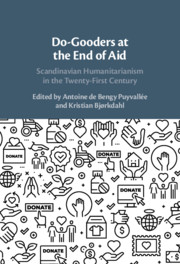Book contents
- Do-Gooders at the End of Aid
- Do-Gooders at the End of Aid
- Copyright page
- Contents
- Figures
- Tables
- Contributors
- Acknowledgements
- Abbreviations
- Introduction
- 1 Fantasy, Distinction, Shame
- 2 The Do-Gooders’ Dilemma
- 3 The Nobel Savage
- 4 A Historical View on the Nordic “Peace Brand”
- 5 Sweden’s Weapons Exports Paradox
- 6 Danish Development Cooperation
- 7 How Democracy Promotion Became a Key Aim of Sweden’s Development Aid Policy
- 8 From Unconditional Solidarity to Conditional Evaluability
- 9 The Pragmatarian Style
- 10 Global Public Goods
- Bibliography
- Index
- References
Bibliography
Published online by Cambridge University Press: 07 July 2021
- Do-Gooders at the End of Aid
- Do-Gooders at the End of Aid
- Copyright page
- Contents
- Figures
- Tables
- Contributors
- Acknowledgements
- Abbreviations
- Introduction
- 1 Fantasy, Distinction, Shame
- 2 The Do-Gooders’ Dilemma
- 3 The Nobel Savage
- 4 A Historical View on the Nordic “Peace Brand”
- 5 Sweden’s Weapons Exports Paradox
- 6 Danish Development Cooperation
- 7 How Democracy Promotion Became a Key Aim of Sweden’s Development Aid Policy
- 8 From Unconditional Solidarity to Conditional Evaluability
- 9 The Pragmatarian Style
- 10 Global Public Goods
- Bibliography
- Index
- References
Summary
- Type
- Chapter
- Information
- Do-Gooders at the End of AidScandinavian Humanitarianism in the Twenty-First Century, pp. 241 - 268Publisher: Cambridge University PressPrint publication year: 2021
- Creative Commons
- This content is Open Access and distributed under the terms of the Creative Commons Attribution licence CC-BY-NC-ND 4.0 https://creativecommons.org/cclicenses/



